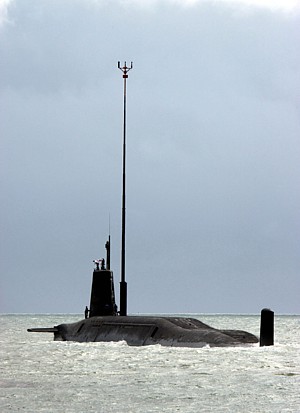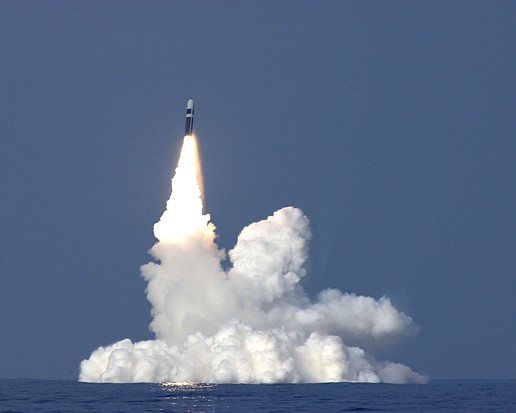|
HMS Vanguard |
 |
| The HMS Vanguard prepares for a DASO (Demonstration and Shakedown Operation) test launch off Florida, October 10, 2005. |



|
HMS Vanguard |
 |
| The HMS Vanguard prepares for a DASO (Demonstration and Shakedown Operation) test launch off Florida, October 10, 2005. |
The Trident D5 missile is a three-stage solid-fuel rocket approximately 13 meters long, over two meters in diameter and weighing 60 tons. It has a range of over 6,000 kilometers. Each missile is technically capable of carrying up to twelve warheads and delivering them on to different targets with an accuracy that can be measured in meters, yet D5s on British SSBNs are thought to carry up to three warheads each. The targeting capabilities of the D5 enables it to carry out both the strategic and sub-strategic roles.
On March 11, 1982, agreement was reached between the U.K. and the U.S. to purchase the TRIDENT II missile system. The procurement of D5's replaced the U.K.'s original request of July 10, 1980, to procure C4's.
Each SSBN carried 16 D5 missiles, but although missiles have been bought from the United States, there is not a set of D5s specifically dedicated to British use. Rather Britain draws on a pool of commingled missiles kept in the U.S. Strategic Weapons Facility Atlantic at Naval Submarine Base Kings Bay, Georgia. Britain has title to 58 missiles but does not own them; a missile that was deployed on a U.S. sub may later deploy on a British sub, or vice versa.
The current British nuclear weapons stockpile numbers "fewer than 200 operationally available warheads," according to the British government. The reference to "operationally available" warheads implies that additional ones are held in reserve - as is the case in the United States and Russia. Although the exact type of warhead deployed on British D5s is not publicly known, it is thought to be very similar to - possibly even a modification of - the W76 carried on U.S. SSBNs.
|
Trident II D5 Launch From HMS Vanguard |
 |
| The HMS Vanguard launches a Trident II D5 the the waters off Florida on October 10, 2005, in a DASO (Demonstration and Shakedown Operation) test. |
The Strategic Defence Review (SDR) from 1998 determined that only one of Britain's four SSBNs would be on patrol at any given time and "carry 48 warheads." The British government reaffirmed this number to Parliament on July 21, 2005. The remaining number of warheads in the stockpile is enough to arm the three other SSBNs with up to three warheads per missile. Yet the 1998 SDR reduced the number of Trident II D5 missiles to be supplied by the United States from 65 to 58, meaning that there are not enough missiles to fully arm all four SSBNs. This suggests a decision to acquire only enough missiles to arm three boats (48 missiles), with the remaining 10 missiles to be used for spares and test-launches. If only 48 missiles are deployable with an average of three warheads, then only 144 warheads (plus spares) are required.
A second indicator of the size of the British arsenal is that Britain assigns its patrolling SSBN a "substrategic mission" to supplement its strategic role. Operationally this probably means that some of the sub's missiles have a single warhead aimed at targets once covered by WE177 gravity bombs, or new targets. These warheads could be used to attack regional adversaries - so-called rogue states - that have weapons of mass destruction, a mission that would not require a substantial attack. The substrategic mission may also require smaller warhead yield options. This can be achieved by choosing to detonate a warhead's unboosted primary, which would produce a yield of 1 kiloton or less, or by choosing to detonate the boosted primary, which would produce a yield of approximately a few kilotons.
The load-out of an SSBN on patrol with strategic and substrategic missions would likely be either 10, 12, or 14 D5s loaded with multiple warheads; the remaining missiles would be armed with one warhead each. U.S. Trident IIs can carry up to eight warheads; presumably those missiles on British submarines can do the same. Assuming a limited upload capability, a few spares, and a number of warheads always in maintenance (and therefore not "operationally available"), the Nuclear Notebook in the Bulletin of the Atomic Scientists estimates the total British nuclear weapons stockpile is approximately 200 warheads.
One submarine is on patrol at any time, and two others are capable of deploying on relatively short notice. The fourth sub is scheduled to be in major overhaul at all times and would take considerably longer to deploy, if at all. The submarine on patrol operates at reduced alert, with the capability to fire its missiles within days of receiving an authentic launch order (rather than within a few minutes, as during the Cold War). The missiles are held in a "detargeted" mode, meaning that target data would need to be loaded into the guidance system before launch, an operation that takes a few minutes. It could also take the sub some time to get into position to launch a missile. While on patrol, the submarine carries out secondary tasks, including hydrographic data collection and exercises with other vessels. During the past few years, a couple of British subs have visited French ports.
The Vanguard Class submarines are larger than the Resolution Class mainly because of the need to accommodate the Trident D5 missile. The 16-tube missile compartment is based on the design of the 24-tube system used by the United States Navy's Ohio Class Trident submarines. Although each Vanguard Class submarine is capable of carrying 192 warheads, the boats will deploy with no more than 96, and possibly with significantly fewer.
D-5 Specifications |
|
| Length: | 13,6 meters (44.6 feet) |
| Diameter: | 2.18 meters (83 inches) |
| Stages: | 3 |
| Throwweight: | 2,800 kilos (6,160 pounds) |
| Fuel: | Solid |
| Range: |
>7,400 kilometers (>4,500 miles) with full payload ~11,000 kilometers (~6,800 miles) will reduced payload |
| Warheads: |
3 x 100-kilotons MIRV for strategic mission 1 x 100-kilotons RV for sub-strategic mission |
| Numbers: | 58 missiles (48 for three SSBNs, 10 spares/test) |